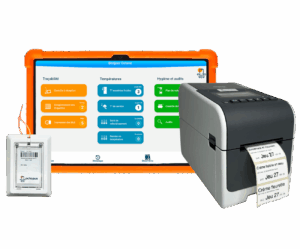How to set up a TIAC protocol in the food service industry?
Comprendre l’HACCP
🗓 Mis à jour le : 20/03/2025
Summary
- Defining a CFTI 🔍
- What are the main causes of CFTIs in catering? 🦠
- Preventing CFTIs for at-risk audiences 🍽️
- What are the main bacteria responsible for CFTIs? 🦠
- What are the symptoms in the event of food poisoning? 😷
- What procedures and conduct should be followed in the event of a CFTI? 📌
- Download your TIAC protocol in PDF 📩
Whether you are a caterer, canteen manager, or responsible for an establishment hosting a sensitive audience (daycare centers, nursing homes…), you must have a clear protocol to manage and report TIAC: to ensure compliance, of course, but above all to know how to react in case of a problem. ✅
In this article, we will provide you with all the keys to best prevent and manage a TIAC in your establishment: causes, prevention, and measures to take in case of a TIAC. As a bonus, at the end of this article, we offer you a TIAC management protocol in PDF. You will be able to personalize it with the contacts of the Regional Health Agency (ARS) and the Departmental Directorate for the Protection of Populations (DDETSPP) of your region and integrate it into your Sanitary Control Plan (PMS). 🎁
Definition of a TIAC🔍
What are the main causes of TIAC in the catering industry?🦠
Non-compliance with Good Hygiene Practices and the HACCP Method 📙
Compliance with the Good Hygiene Practices Guides (GBPH) and HACCP principles is essential to prevent all contaminations caused by:
- Poor personal hygiene 🧼
Poor personal hygiene is one of the main causes of TIAC. Indeed, your staff are in constant contact with food products from preparation to service. Poor handwashing is one of the primary causes of contamination, especially after using the restroom or handling waste or raw products. 🥩
- Cross-contamination 🦠
Cross-contamination is another major cause of bacterial transmission in the kitchen. It occurs when a safe food comes into direct or indirect contact with a contaminated food or soiled equipment. For example, placing cooked food on a surface that was used to prepare raw products (such as raw poultry contaminated with campylobacter), or using the same utensils for different foods without disinfecting between uses.
To prevent this risk, a clean environment is mandatory. Lack of disinfection of work surfaces, utensils, or equipment can promote bacterial growth. Moreover, food professionals often use complex equipment (blenders, slicers, etc.) that require disassembly and more thorough disinfection than a simple cutting board to avoid any risk of contamination. ✅
Poor Cold Chain Management ❄️
Poor management of the cold chain can also promote bacterial growth and turn food into a contamination vector that can cause food poisoning. Breaking the cold chain can happen in different ways:
- Defective equipment ⚙️
A poorly set refrigerator or a broken cold room can cause a break in the cold chain. For these reasons, it is important to regularly check the temperature of your cold rooms, ensuring your thermometers are properly calibrated. You can do this manually with a thermometer or remotely using connected temperature sensors. Applications like Octopus HACCP allow you to remotely monitor the temperature of your cold rooms thanks to connected temperature sensors and receive SMS alerts directly in case of anomalies.
- Non-compliance with storage temperature requirements ⏳
Even with functional equipment, if the storage temperatures of your products are not respected, bacteria risk developing. For example, storing sensitive products like meat above 3°C, leaving food too long in the danger temperature zone (between 10°C and 63°C), especially during warming or rapid cooling, or refreezing a thawed product, are all risky situations.
Poor Cooking of Sensitive Products 🔥
Insufficient cooking will not destroy bacteria and can cause a foodborne illness outbreak (TIAC). Some sensitive products require proper cooking to minimize the risk of contamination, such as:
-
Ground meats: +70°C (158°F) at the core for at least 2 minutes
-
Poultry: +74°C (165°F) at the core for at least 2 minutes
-
Fish and seafood: +63°C (145°F) at the core for at least 1 minute
Prevention of Foodborne Illness Outbreaks (TIAC) for At-Risk Groups 🍽️
Certain populations are particularly vulnerable to foodborne illness outbreaks (TIAC), such as elderly people in nursing homes (EHPAD) and young children in daycare centers. Their immune systems are weaker, and food contamination can have serious consequences. This is why prevention measures must be put in place to ensure their safety.
The Specific Case of TIAC in Nursing Homes (EHPAD) 👵
Elderly people are more sensitive to TIAC due to weaker immune systems and slower digestion. In nursing homes (EHPAD), TIAC prevention relies on several precautions:
- 📙 Compliance with Good Hygiene Practices (GBPH): Hand washing, surface disinfection, and strict application of HACCP protocols are important to limit contamination risks.
- 🧀 Avoid risky foods: Some products like raw milk cheeses, artisanal cold cuts, or raw eggs carry higher risk and must be carefully considered on menus.
- ❄️ Control of the cold chain: Ensure proper storage temperatures (minced meat and fresh fish at 2°C, homemade preparations at 3°C) with regular checks of refrigeration units.
- 🔥 Proper cooking: Cook foods thoroughly and verify that the final cooking temperature is above 63°C to destroy pathogenic bacteria.
- 🌡️ Strict temperature management during service: It is essential to control the temperature of dishes before serving. Hot dishes must be kept at +63°C minimum until service (watch the temperature in serving carts), 70°C is recommended to eliminate risks. For cold dishes, maintaining them at +3°C is recommended to prevent bacterial growth.
The Specific Case of TIAC in Daycare Centers 🍼
Young children are particularly vulnerable to TIAC due to their immature immune systems. In daycare, food safety is based on several measures:
- 🧀 Avoid risky foods: Certain foods, like raw fish or unpasteurized dairy products, must be avoided to prevent danger.
- 📙 Compliance with GBPH: Hand hygiene, surface disinfection, and adherence to cooking temperatures are mandatory to reduce contamination risks.
- ❄️ Control of the cold chain: A major risk of cold chain break occurs when parents bring their children’s meals without respecting proper cooling and storage hygiene practices. Awareness is key! On site, make sure to check fridge temperatures for food storage.
- ♨️ Serving temperature: Serving dishes that are too hot can cause burns to young children. However, regulations require reheating foods to a minimum of 63°C to guarantee food safety. To balance both needs, dishes should be allowed to cool after reheating (maximum 2 hours) to reach a temperature safe for children’s consumption.
What are the main bacteria responsible for foodborne outbreaks (TIAC )? 🦠
- Salmonella:
Found in eggs, poultry, raw meat, and dairy products, Salmonella is one of the main causes of foodborne outbreaks (FBO). Contamination usually occurs due to insufficient cooking. It is eliminated by cooking at 72°C (161.6°F) for 15 seconds (pasteurization), or 65°C (149°F) for 5 to 6 minutes, especially for meats. 🥩
- Escherichia coli (E. coli):
It is mainly found in undercooked ground beef; we therefore recommend cooking frozen hamburger patties directly without prior thawing. E. coli can also be present in unpasteurized dairy products or on fruits and vegetables that have come into contact with fecal matter. Vegetables should therefore be thoroughly decontaminated.
- Listeria monocytogenes:
This bacterium resists cold temperatures and grows in refrigerated foods such as unpasteurized dairy products, cold cuts, smoked fish, and prepared dishes. It is particularly dangerous for pregnant women, elderly people, and immunocompromised individuals. 👵
- Staphylococcus aureus:
This bacterium produces a heat-resistant toxin. It is mainly transmitted via the hands of an infected carrier and generally contaminates prepared foods left at room temperature, such as composed salads, cold cuts, sandwiches, and pastries. 🍰
- Clostridium perfringens:
Present in soil and the digestive tract of animals, this bacterium multiplies in stews, cooked meats, and foods left too long at room temperature.
- Bacillus cereus:
It is mainly found in rice, pasta, and stews when they are poorly stored or reheated. ♨️
What are the symptoms of food poisoning? 😷
FBO (Foodborne illness) can manifest in different ways. Symptoms may vary depending on individual sensitivity, the responsible bacteria, and the amount of bacteria ingested. The main symptoms of FBO are:
- Digestive disorders
Stomach aches, abdominal pain, vomiting, and diarrhea often appear quickly after consuming contaminated food. The pain can range from mild to severe, often presenting as cramps or bloating. These symptoms are common in infections caused by E. coli or Clostridium perfringens.
- Fever
Some infections, such as those caused by Salmonella or
What procedures and actions should be taken in case of FBO? 📌
What does the HACCP regulation say? Foodborne outbreaks (FBO) are part of the list of notifiable diseases. They must be reported by doctors or biologists to the Regional Health Agency (ARS) or the DDESTPP. This notification helps to prove the existence of the FBO, assess its scale, identify its origin, and implement corrective measures.
FBO Reporting Protocol 🔊
Fill out the mandatory form: Cerfa FBO declaration
Alert the competent authorities 📌
As soon as two cases present similar symptoms after consuming the same meal, it is mandatory to report the FBO to health services. The declaration must be made to:
- 📞 The Regional Health Agency (ARS), through its Medical Inspector, who will coordinate the epidemiological investigation.
- 📞 The Departmental Directorate of Employment, Labor, Solidarity and Population Protection (DDETSPP), formerly DDPP (also known as DDCSPP…), which will conduct sanitary investigations and monitor compliance with hygiene regulations.
Keep evidence 🔎
To facilitate the investigation and identify the source of contamination, several items must be preserved:
- Sample dishes — these samples must be kept sealed, labeled, and stored in a cold room at +3°C maximum for 5 days after being served.
- Biological samples (stools, vomit) taken from patients when possible, which will help identify the bacteria or toxin involved.
Subsequently, a thorough investigation must be conducted to better understand the circumstances of the contamination. Therefore, gather:
- The list of guests and staff members who handled the food.
- Details of meals served during the 5 days prior to symptom onset (storage conditions, dishes used, etc.).
- The list of patients with their symptoms, date and time of first signs.
Corrective measures and prevention ✅
Once the cause is identified, actions must be implemented to prevent a new FBO occurrence in the establishment. These measures may include:
- 🧼 Strengthening good hygiene practices, notably hand washing, surface disinfection, and adherence to HACCP procedures. For example, to avoid cross-contamination, you can implement a forward flow system or perform surface tests with agar slides.
- ❄️ Better cold chain management, with temperature control during storage. To facilitate your temperature recordings, you can use apps like Octopus HACCP. Connected temperature sensors can take measurements for you. You can remotely check if your temperatures are compliant and be alerted in case of anomalies.
- 🧑🎓 Awareness and training of staff on food risks and sanitary safety rules, especially hand washing after any contaminating action. Every month, we regularly offer free training sessions on various HACCP topics!
Regular monitoring of cleaning and disinfection procedures of kitchen equipment and premises.
Download your FBO reporting protocol in PDF 📩
To assist you in managing FBOs, we offer a free downloadable protocol in PDF. You will find the essential steps to follow in case of an FBO.




